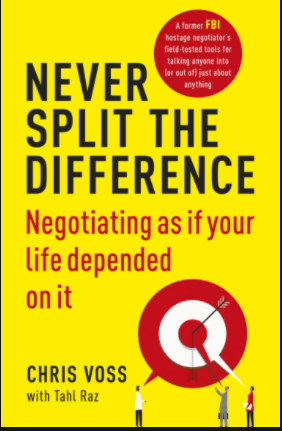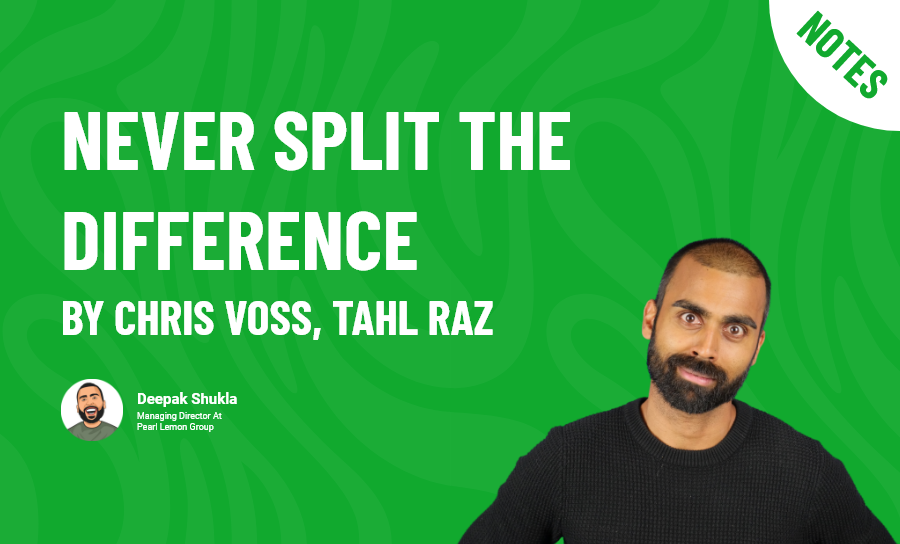
Click this link to purchase from Amazon.
Click this link to purchase from Audible.

Deepak Shukla’s Notes On Never Split the Difference by Chris Voss, Tahl Raz
Hey guys,
I finished reading this book on the 10th of January 2021.
Here’s a synopsis of the book I grabbed from Amazon:
“A former international hostage negotiator for the FBI offers a new field-tested approach to high-stakes negotiations – whether in the boardroom or at home.
After a stint policing the rough streets of Kansas City, Missouri, Chris Voss joined the FBI, where his career as a hostage negotiator brought him face-to-face with a range of criminals, including bank robbers and terrorists. Reaching the pinnacle of his profession, he became the FBI’s lead international kidnapping negotiator.”
And here are my actual notes I took whilst I was listening to this on Audible:
- Pushing hard for what you need/what is right is honest and ethical
- Genuine honest conflict can actually help progress
- The adversary is the situation – the person you in conflict with is your partner!
- We know of many couples who get a divorce without ever arguing
- Most people mess up because they fear conflict itself
- Overcoming fear to get what you want in life
- When it doesn’t make sense if often makes cents (ie opportunity to learn some valuable information)
- Interruptions / interruption of flow / odd exchanges – often leads to people cracking. Pay attention to this because it can reveal a goldmine
- Why reporters always keep mics on because at the beginning and end when the main thing is done is often when you learn the most
- Observe unguarded moments
- Hidden interests often confused as irrationality
- Religion as a reason
- When the partner expresses goals – express your concurrence for their ability to achieve them
- When someone displays passion and purpose for what we always wanted it’s intoxicating. We all want a map to joy and it makes us relive our childhood spirit
- Listen for something that reveals a particular outlook or perspective and then find vocabulary that will help them identify with you
- Similarity Principle – trust people more who we think are similar to us
- Get people to come in as backup listeners
- Get recordings if possible to listen again and listen some more
- Review everything you hear – you will not catch everything the first time
- Using other guys religion against him Is an extremely powerful negotiation tool
- By positioning your demands within the world view your counterpart uses to make decisions – you show them respect
- The paradox of power – the harder you push the more pushback you get
- Understand their religion – aka their world views and beliefs (whether religious or not)
- You want to see what language someone speaks and speak it back to them
- Understanding normative leverage can be as simple as Asking what your partner believes and just standing back and listening
- Normative leverage
- Sentences like ‘it seems clear that you’ve always valued that you pay on time’ or ‘it seems like you don’t care what position you are leaving me in’
- People will act irrationally and shut off the negotiation if feel under threat
- People will do than give up their autonomy so be mindful when making a threat
- Loss aversion is real as a threat – if you don’t do X I will do Y
- Remember if someone says ‘I want’, you have positive leverage
- Eg you have more leverage than you think in negotiation kidnapping. What business is successful with only one buyer?
- Black swans are leverage multipliers
- Black swans can be completely innocuous and hidden in plain site
- Why are they communicating what they are communicating right now
- Don’t verify what you expect
- Feel for the truth behind the camouflage
- Ask lots of questions and read non verbal cues
- Each side is in possession of at least 3 black swans that if were uncovered would change everything
- Always retain a beginner’s mind
- Every situation is new. We must let our known knowns guide us but not dictate what happens
- When the pressure is on you don’t rise to the occasion you fall to your highest level of preparation
- Ackerman method for haggling
- Set your target price
- Set your first offer at 65% of your target price
- Calculate 3 raises of decreasing increments of 85/95/100%
- Use Empathy and lots of ways of saying no before you get the other side to increase your counteroffer
- When calculating your final price use specific non round numbers – gives number credibility and weight
- Throw in your final offer with some non monetary item that they probably don’t want
- Unsolved issues are the problem not the person
- Why would you do THAT? (Tone here very important)
- ‘Why did you do that?’, only ever used to knock someone back
- Threats delivered with poise – ‘I’m sorry that just doesn’t work’ – very effective
- For anger to be effective it has to be real but you also need to control it
- Real anger. Threats without anger and strategic umbrage
- You bake with the flour you have
- You can’t be what you’re not.
- Have you understand their type be opening yourself up to their normal
- Don’t treat others the way you would like to be treated to treat others the way they want to be treated
- I am a normal paradox
- Accomodator
- Time spent building a relationship
- Want win-win
- Will become friends with other side even if agreement not reached
- Yield concession to appease or acquiesce and hope another side reciprocates
- Social accomodating peace-seeking and poor time managers they probably accommodator
- Be social and friendly
- Analysts –
- Methodical and diligent
- Not in rush
- Their motto – as much time as it takes to get it right
- Prefer to work alone
- Rarely show emotion
- Self image linked to minimising mistakes
- Rarely deviate from their goals
- Do well with FM DJ voice
- Speak off in a way that’s distant And cold instead of soothing
- Pride themselves on details. Will spend weeks on it to prevent being shown up
- Analysts hate surprises
- Information gathers and problem solvers – hyper sensitive to reciprocity
- Sceptical by nature
- Don’t expect immediate counter proposals by them
- Asking too many questions at start bad idea because they want to understand all the implications, pays to be prepared
- Silence is opportunity to think
- Don’t adlib
- Apologies of little as they see negotiation and their relationship with you as separate things
- Respond well to labels
- Not quick to answer calibrated questions
- May need few days to respond
- If you’re analyst you should worry about cutting yourself off from your biggest piece of data – your counterpart
- People will be more forthcoming as a result if you smile
- Smiling used for when caught off guard
- To be good you have to learn to be yourself at the table. To be great you have to add to your strengths
- Personal negotiation style
- Chapter 9: Bargain Hard
- More of ‘we, they and them’ is savvy decision maker who keeping his options open
- If you hear a lot of “I, me and my” authority probably lies elsewhere
- Yes is nothing without how
- You can express no 4x before you actually need to use the word
- Best way to get your counterparts to lower their offer is to say no using how questions – how am I supposed to do that
- Humanise yourself – say your name in a fun friendly way and get your own special price
- Include your name ‘my name is Deepak’ 🙂
- When people lying these are the signs:
- Liars use more words than truth tellers
- Use far more third person pronouns like ‘you, him it they them’ rather than I
- Liars tend to speak in more complex sentences in a bid to win over their suspicious counterparts
- Ie try to baffle people with bullshit
- Ask yes for 3 times in different ways uncovers falsehoods and incongruences that might not come up if just once
- 7/38/55 words body language and tonality best ways to gauge people
- How do we ensure the managers of those we are training are fully onboard
- How do we make sure we deliver the right material to the right people?
- How onboard is the rest of your team
- How does this affect everybody else?
- How will we know when we’re off track?
- How will we know when we’re on track?
- The art of letting someone else have your way
- A deal is nothing without good implementation
- Use some variation of ‘how can I do that?’ creates forced empathy
- Yes is nothing without how
- Bite your tongue!!
- Who has control is discussion the guy listening or the guy talking? Guy listening of course
- When you’re attacked in a verbal skirmish step back and ask a calibrated question – will change entire tenor of conversation
- Pause think and let passion dissipate
- Self control is most important thing
- How am I supposed to do that forces counterpart to do your work for you and internalise your POV
- What’s the objective here?
- What is it that you want?
- What are we trying to accomplish here?
- How can we solve this problem?
- What is it that bought us into this situation?
- How can I help to make this better for us?
- What about this is important to you?
- What is the biggest challenge you face?
- What and how are most important openers
- Don’t use ‘why’ it can backfire very easily
- How would you like me to proceed
- How can I help make this better for us?
- What about this is important to you?
- Calibrated questions –
[convertful id=”197358″]
- Design questions to take someone somewhere
- Avoids words like can / is / do or does
- Start with reporters questions – who what when why and how
- These words inspire counterpart to think expansively
- Better to cut further and start with what how and sometimes I
- Who when where and why can often get 1 word answers
- When you are negotiating payment terms you can summarise challenge discuss why it’s a challenge for you and then ask the question – how am I supposed do that?
- How am I supposed to do that? Is a great question for asking someone to figure out how to help you
- He who learns to disagree without being disagreeable has learned the most valuable secret of negotiation
- Our job as persuaders is not to get them to believe what we say. But to get them unbelieving
- Giving counterpart illusion of control by asking calibrated questions by Asking for help – one of most powerful tools for suspending unbelief
- Key is to stop people from unbelieving in a negotiation
- Coopting not coercing. Coaxing
- All negotiations are defined by a subterranean pattern of desires and needs
- If someone gives you guidance and it’s specific and detailed they will have a vested interest in watching you implement and seeing if you succeed
- Ask ‘what does it take to be successful here?’
- Spark their interest in your success and you gain an unofficial mentor
- Pleasant persistence on non salary terms
- Always use specific numbers – odd and never with zero’s
- Figure out what’s cheap to yourself but valuable to your counterpart
- If you offer a range expect someone to come in at the lower end
- Eg I’m about to tell you something and it isn’t good you’re going to think ‘X/Y/Z’
- Anchor their emotions by acknowledging all their fears
- Loss aversion – to get real leverage have to convince someone they’ve got something to lose if the deal falls through
- Prospect theory – Kaunheman
- You can use ‘We’ve given you a fair offer’
- If someone uses ‘F’ bomb against you then you say ‘I see – well ok let’s go back to the part that you felt wad unfair and look at it again’
- You can drop the ‘F’ bomb to get a better deal – I just want what’s fair
- Important you share deadline you have with opponent to get to crux of matter fast
- Deadlines are almost never ironclad
- No deal is better than a bad deal
- Deadlines are boogeyman of negotiation unsettling us unnecessarily
- Deadlines are almost ALWAYS arbitrary and never trigger consequences of any matter
- Imaginary deadlines create a fear in people that causes them to make irrational choices
- Don’t fall for the line in the sand or false sense of urgency to believe that doing a deal now is better than doing a good deal
- Make time your ally
- Don’t settle. And never settle the difference
- Compromise is often bullshit. We compromise to avoid fear and to avoid pain. Too few are driven by their actual goals
- We compromise because it’s easy and it saves face and to be safe
- Chapter 6 Bend their reality
- This can massively with my relationship also with Daniela
- Using ‘thats right’, to make a sale – can turn a no into a yes
- Figure out what someone needs to hear to finish with the words ‘thats right’ – this creates environment for subtle epiphany
- Drive towards that’s right. Not ‘you’re right’ – that changes nothing and is actually a disaster
- Every tactic in the listening arsenal
1. Effective pauses – silence is powerful (told Benji to use it for emphasis) – keep using it till eventually emotion is drained from a dialogue
2. Minimal encouragers – ‘uhuh’/’yes’/’ok’/’i see’ to convey you’re paying full attention and what person has to say
3. Mirroring (repeat back what person says)
4. Labelling (give his feelings a name and identity with how he felt) eg it’s all terribly unfair and I can see now why you sound so angry
5. Paraphrase – repeat what he saying back in your own words
6. Summarise – paraphrase + labeling = summary
7.Ultimately the only way from here is for person to say ‘thats right’
- Get them to say a ‘thats right’, several times to make them more malleable and to get to suble epiphany
- Need to create a subtle epiphany
- Them saying ‘yes/yes/yes’ doesn’t open up pathway to internal change – must apply behaviour stairway model instead
- Sweetest words in any negotiation are ‘thats right’
- Unconditional positive regard is how you need to accept anyone to open up a path to true change
- Process is: behaviour stairway change model – 1. Active listening 2. Empathy 3. Rapport 4. Influence and 5. Behavioural change
- CNU @ Quantico are FBI top dogs for hostage negotiation
- Negotiation is about convincing the other party that what you want is their own idea
- Is now a bad time to talk instead of ‘do you have a minutes to talk’ encourages a no which empowers prospect
- Aim for no at the start enroute to getting your yes
- One line email you can use – Have you given up on this project?
- Can also say ‘lets start with what you don’t want’
- Sometimes difficult to get people into saying ‘No’ so need to do it purposefully by miscategorising
- Start with no – Jim camp
- Embrace the no
- Go for the early no
- Start with ‘is now a good time to talk?’
- Beware a plastic/early Yes. a counterfeit yes. No starts the conversation
- Start with their most basic wants
- Two kinds of yes
- Commitment yes is one you want
- Three sound almost exactly the same
- Persuade in their world
- Practice hearing no as something other than rejection and respond accordingly
- What about this bothers you
- What is not working for you
- I don’t think I understand
- I don’t think I can afford it
- I want some more information
- Welcoming them to say no brings down many barriers and actually opens up communication
- No often decision frequently that changes so let other person have no because it makes them more open to help you get to yes later
- No starts the negotiation
- Use labels to reinforce positive perception and dynamics
- List worst things party can say about you
- Focus on clearing the barriers to an agreement first
- Empathy, after someone has an argument, is a brilliant strategy as person is searching for a human connection
- When you list someone’s fears or negative thoughts they often add colour and nuance to them which gives you more information
- Anticipate all negative things other side might think about you and list them out
- Accusation audit
- Taking the sting out
- ‘it seems that you are really passionate about X and really want to make sure you’ve Found the right Y
- ‘i’m sensing some….’
- Clear the road before advertising the destination
- When writing stuff make it more emotional as a means of stirring up a particular emotion
- Research shows best way to deal with negativity is to observe it without judgement or without a reaction
- Whenever make a mistake go right at it as fast as possible
- Labelling is a tactic not strategy
- Try now. Label an emotion then be silent. People will open up
- It seems like / it sounds like. Don’t say ‘i’m hearing that’ – use of pronoun ‘I’ makes it feel selfish like you aren’t interested in others feelings
- Words / tone / body language = words music and dance. Spot feelings is about how people respond when you ask them questions
- Labelling an emotion – moves emotion into rational part of brain thus removing it’s intensity
- Labelling is a way of naming the way someone feels without making reference to any other external factors
- Neural resonance
- Tactical empathy is emotional intelligence on steroids
- Put a smile on your face always!
- SLOW IT DOWN. Most common mistake negotiator’s make is going too fast. Ends up making people feel like they are not being heard
- Negotiation is not an act of battle but a process of discovery
- Oprah Winfrey = amazing negotiator (watch some of her shoes)
- Mirroring will make you feel uncomfortable when you first try it – but it’s a valuable Swiss army knife for conversation in every social setting
- Mirror will get you the clarity you want whilst respecting and listening to what other person is saying
- Ask someone ‘what do you mean by that’ and you’re likely to incite defensiveness or irritation
- Intention behind most mirrors is please help me understand?
- How to deal with any type of conflict: 1. Use late night FM DJ voice 2. Start with I’m sorry 3. Mirror 4. Silence 5. Repeat
- Being right isn’t the key for a negotiation. Having the right mindset it
- Mirror for FBI when you repeat last word or last 1-3 words of what somebody said
- Waiters who used mirroring instead of positive reinforcement got 70% more tips
- Generally an unconscious behaviour
- Mirroring also called isopraxism – essentially imitation
- When you mirror someone they can start vomiting information
- You can be very direct and to the point as long as you use a tone of voice that says ‘im ok you’re ok – let’s figure things out’
- Radio DJ voice is smooth downward inflecting and drawn out – I’m in control
- Smile in your face and smile in your voice will increase your own mental agility
- These voices are cross cultural and never fail regardless of location
- Three times of voice available to hostage negotiators
- Late night FM DJ voice
- Positive playful voice
- Assertive voice (forget this)
- We grasp what the other person is feeling without even intending to
- How we are – general demeanor and mode of delivery – easiest things to enact and best tool for change
- Listening is where negotiation starts. Validating them emotionaly and making them feel safe
- Active listening requires quietening your inner voice – which takes extreme effort – most people can’t do it
- Life is negotiation
- Tactical empathy
- When someone listened to intently they tend to listen 👂 to themselves more carefully
- Listening intensely is worlds cheapest form of therapy
- The universal premise that everyone wants to be listened to and understood
- Two systems of Thought – animal mind (fast) and rational mind (slow)
- Kidnappers are just business man trying to get the best price
- ‘How am I supposed to do that?’ is a very good challenging technique and variations of this work well
- Be the smartest dumb guy in the room
- When in a tough negotiating position ask ‘innocent’ open ended questions to change the frame of the conversation



